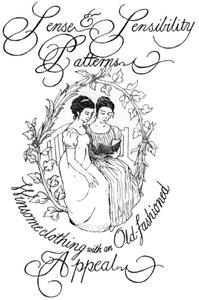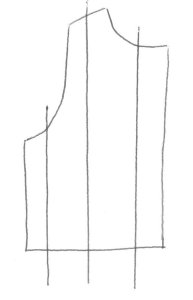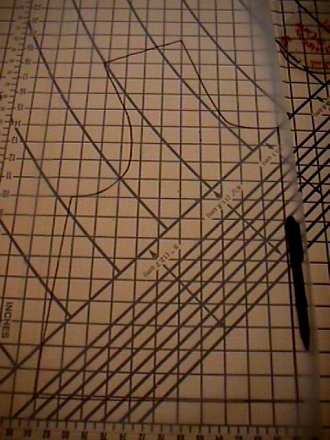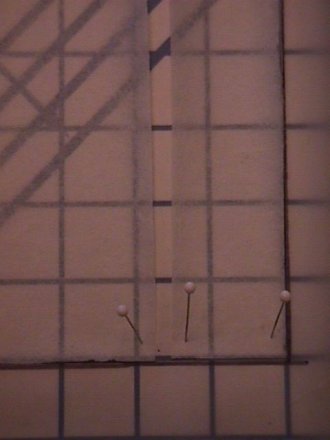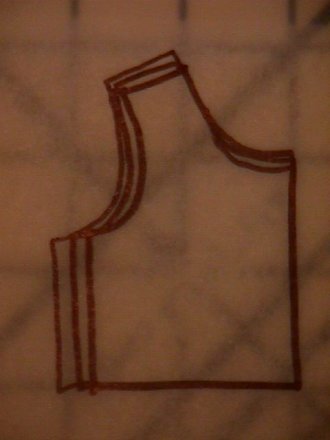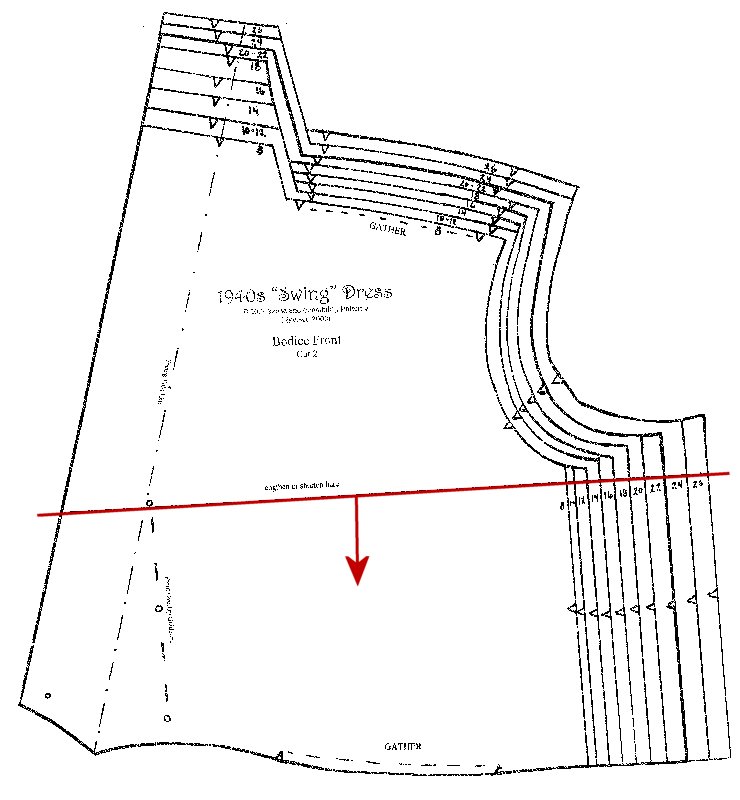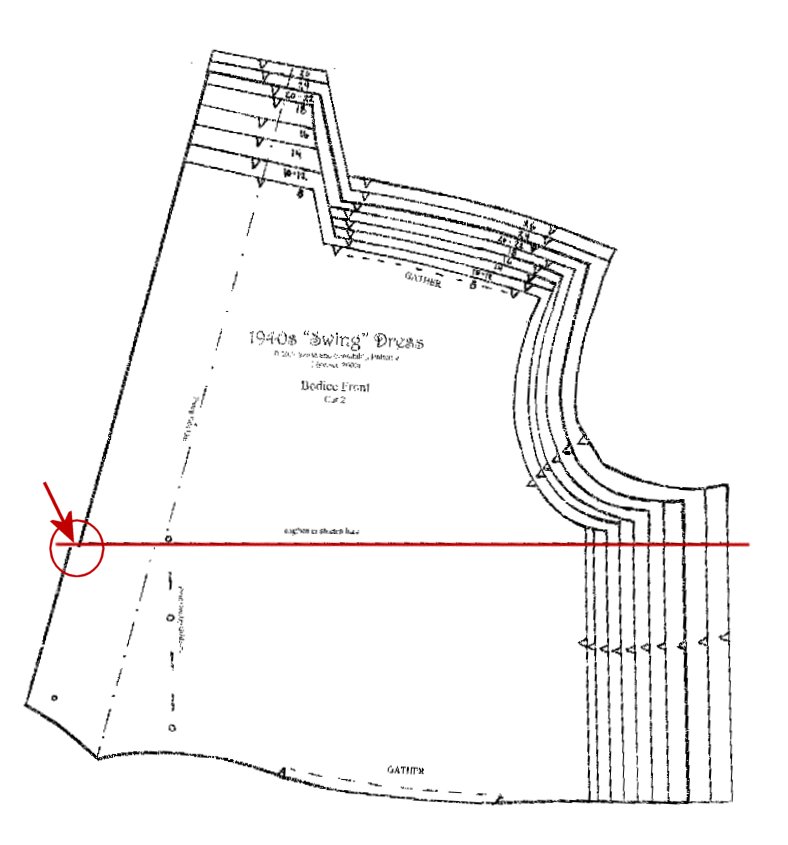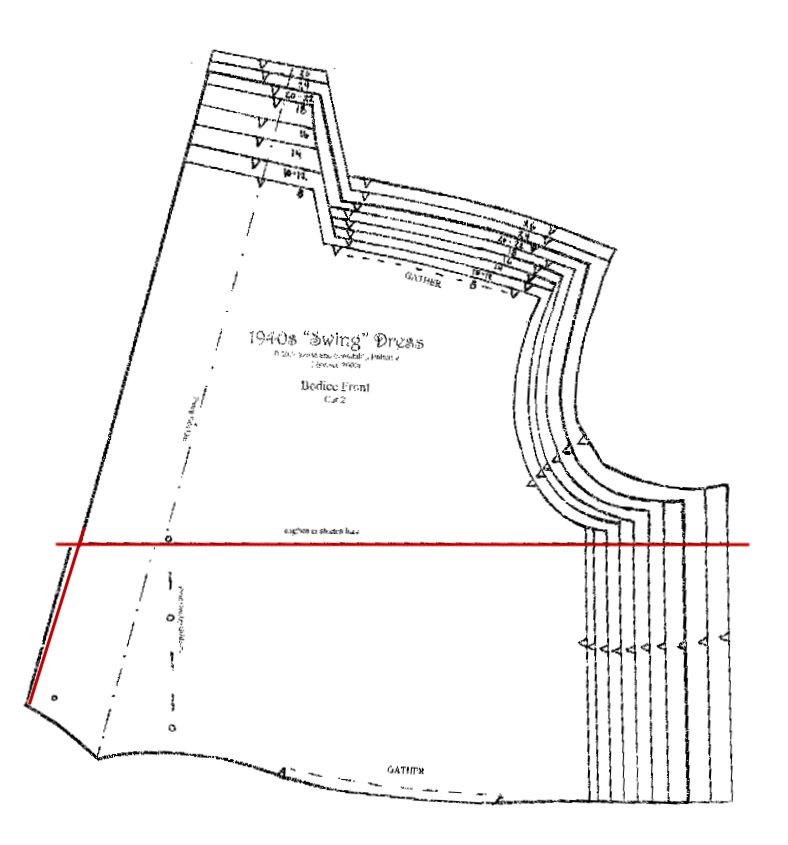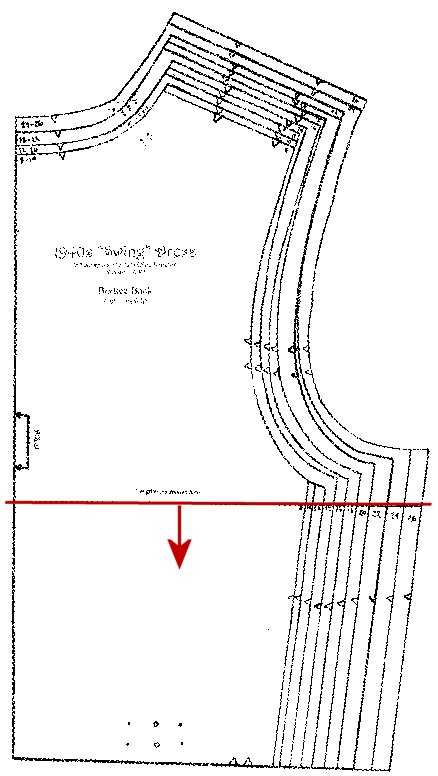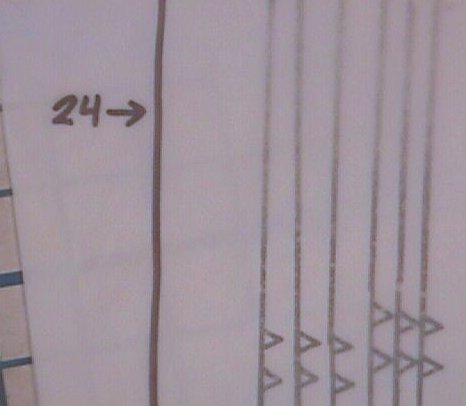How to Resize a Pattern
No matter how well designed a pattern may be, it cannot fit each individual perfectly. Each human body has its own quirks, and each person has different fitting needs. You may find that you need to enlarge a pattern beyond the sizes available on the sheet, or you might need to shrink it. Perhaps you would like to reduce a woman's pattern to fit a little girl. Or maybe you found an out-of-print pattern you'd love to make ... but the sizes are too small for you. Anything is possible once you know how to resize a pattern! And it isn't hard at all -- it just takes a bit of time and work. I'm here to show you how it is done so that you will never be limited by pre-printed pattern pieces again!The method for shrinking or enlarging the pattern pieces is similar for each piece. Throughout this section, I will assume you are starting from a size 12 and will show you how to size down one size (to a 10) and up one size (to a 14). From there, you will be able to do all the rest of the sizes!
The Tools of the Trade
Before you begin, I recommend that you have the following tools at hand:
Cardboard cutting surface with one-inch grid (available at any fabric store)
French curve(s) -- plastic curves to help you trace your armholes, necklines and other curves (you can get these from Sew True)
Swedish interfacing (available at Birch Street Clothing) or heavy-duty pattern paper (like vellum)
Tracing paper (available by the roll from architectural supply stores)
Sharpie markers for tracing
Pins
Scissors
Getting Started: The Bodice
First, let's start with a bodice front. If you want to enlarge the bodice, first trace the bodice piece onto Swedish interfacing or sturdy tracing paper, so you have a piece you can slash for resizing. To size up to the 14, slash the bodice front like this:
Notice that you are splitting down the center of the underarm, the center of the shoulder and the center of the neckline/bust. You will split the back bodice piece in exactly the same manner. Now, the difference between size 12 and size 14 in the bust area is two inches (12 is 34"; 14 is 36"). You want to add evenly to the front and back bodice pieces, which means adding a total of one inch to each piece. Now half that again, since you are adding to only one half of the bodice, and that means you have a total of 1/2" to add to the bodice front and back pieces. Here is what the pattern piece will look like when you spread it apart:
In your typical commercial pattern, the computer splits up the half inch and adds 1/3 of it at each place where the pattern has been split. I do not recommend this! This method often creates a very bad fit, particularly in the shoulder area. The biggest complaint I hear from women over a size 22 is that shoulders on most modern patterns are way too wide for their size. Just because someone's bustline is larger does not mean she has linebacker shoulders! So my suggestion is that you size the shoulders up only slightly and only for size 18 or 20 (then just keep that new width for the rest of the big sizes unless you do happen to be particularly broad in the shoulders). Same with sizing down -- just make them smaller for sizes 10 and under -- and only slightly smaller. I'd recommend that you add nothing to the shoulder split to go from size 12 to size 14 (or 16). Instead, add 1/4" to the bust split and 1/4" to the underarm split. For size 18, add 1/8" to the shoulder split, then 1/8" to the underarm split and 1/4" to the bust split. Most women find they need more room in the bust -- not in the shoulder area.
To draw the newly sized pattern piece, first roll out your tracing paper (not interfacing) on your grid board. Pin the starter pattern piece (in your starting size) to the tracing paper, using your grid lines to help you keep things straight, like this:
Now trace around it so you have your first piece “set in stone.”
Now split your first pattern piece and spread it as I explained above to go up to your next size:
Here's a close-up so you can see the 1/4" spread:
Now trace all the way around the spread piece, omitting the shoulder for now, and you end up with this:
Here's a close-up of how the shoulder and neckline will look:
Now, most patterns add about an eighth of an inch to a quarter of an inch to the top of the shoulder and the neckline, since you assume that larger sizes need more room in the bustline and will need more length in the bodice front. Even this small amount at the shoulder adds a helpful amount to the overall fit of the bodice. Now, you add to the neckline because you added to the shoulder -- if you didn't add to the neckline, it would be lower, and you don't want to do that.
So, adding to the shoulder looks like this:
Adding to the neckline looks like this:
Okay, let's go ahead and size down before we talk about some other issues around the neckline and shoulder area. Pin your split pattern down again, this time overlapping where you had spread the pattern last time, like this:
Here's a close-up of that overlap:
Trace around this pattern, then "shrink" the shoulder and neckline, so your final pattern looks like this:
Okay, now you're probably wondering about that shoulder area. The shoulder moves outa bit with each size, as you can see. You end up with a jumble of lines running from the neckline to the shoulder as you go. If you've looked at my patterns (and practically any other pattern on the market), you know that there is one smooth line running from the neckline to the shoulder for all sizes together. That is due to nesting sizes in such a way that you avoid confusion. What you want to learn to do is to smoothly blend the pattern pieces together so that you don't have a densely packed jumble of neckline cutting lines. The first way to learn to do this is to trace each new pattern size individually (not on top of the last one). Once you have all the pattern sizes traced out, you can lay them down, one on top of the other (largest on the bottom, smallest on the top) and line up the neckline-to-shoulder edges so they meet. Then you trace your master pattern off this conglomeration, and it will look something like this:
After you've been working on pattern sizing for a while, you'll just get an eye for how sizing works, and you will not even need to split patterns any longer. You will be able to trace your master piece, then add to it at the appropriate places (armhole, shoulder, side seam, neckline). Splitting patterns and spreading will be your "training wheels" until you become confident enough to just draw out the new sizes using your measuring tape and french curves!
Special Help for Long- and Short-Waisted Ladies
If you are as short-waisted as I am (15" from nape to waist), you already know that the waistline of just about every average pattern hits you on the hipline. To correct this, there is usually a "Miss Petite" line across the pattern to show you where you can shorten the bodice (or lengthen it if you're long-waisted). You can do this on any pattern with or without the "Miss Petite" line. Just pick a spot about two inches above the waistline and draw a horizontal line across the pattern, like this:
If you are short-waisted, you can just fold the pattern down at this spot to match your waistline (plus 5/8" for a seam allowance). If you are long-waisted, you just slash and spread like you've been doing above.
For bodices of unusual shapes, like the one in my 1940s "Swing" Dress pattern, you'll need to tweak a few lines after folding down the bodice. I've illustrated this below.
This image shows the bodice as-is with the lengthen/shorten line across the center in red:
In the next image, you see the bodice folded down to accommodate a short waist. I've circled the "problem" area this creates:
As you can see, the long line of the bodice front no longer matches. To fix this, simply use a straightedge to redraw the line so that it runs smoothly from above the shorten line to the lower point:
As you see, this shaves off that problem line that is sticking out, but you still have the continuous line of the bodice front from top to bottom. For the bodice back, you'll do the same thing. First, here's the bodice back with the fold line in red and the arrow pointing down to show that you'll fold the bodice down the required amount for your nape-to-waist measurement:
The next image shows the bodice shortened, and I've again circled the "problem" area:
The size lines no longer match up at the side seam, so you'll once again grab your ruler and simply smooth them back out:
That's it! Always start at the top and work your way down to keep the sizing accurate, since the size just below the armohole hasn't been altered in any way by shortening the bodice. By the time you reach the bottom of the bodice side seam, your new line matches up perfectly.
Further Tips for Making a Child's Pattern
To shrink an adult pattern down to fit a child, you will slash and spread not only vertically, but horizontally, as shown here:
The armhole of an adult pattern is going to be far too large for a child, so you will need to shrink it by overlapping the pattern at the upper line (you can fold, but I think it is easier to slash and overlap). To determine the correct depth of the armhole, measure the child from the top of the shoulder down to her underarm "seam." An easier way to do this is to find a garment that fits the child nicely (a tailored shirt or dress with a comfy armhole), then measure that from the shoulder seam down around to the underarm seam. Add 5/8" to the shoulder and side seam for your seam allowance, and there is your front armscye (armhole) measurement. You can repeat this for the back, then just double-check to make sure the side seams of the bodice front and back match correctly.
Use your french curve to redraw the armhole curve (which will look a bit funny after you've overlapped the bodice at this point!). The old armhole will be a guide to help you see where the new curve needs to go...only the new curve will be a miniature of the old.
The rest of the adult bodice is going to be too long-waisted for a small child as well, so that's where you'll use the other vertical line. Just shorten the bodice as you would for a short-waisted woman, taking up as much as is necessary to place the waistline at the child's waist (or empire waist, as the case may be), plus 5/8" for your seam allowance. Ta-da!
Make Muslin Your Best Friend!
Now, obviously, testing pattern pieces in muslin plays a very important role here. You want to test your new pattern pieces and fit them to a properly sized mannequin (or yourself or the person for whom the new pattern was made). You sometimes discover fitting quirks (like shoulders that are too wide for the average) when you do this, and you can adjust the toile to fit. When the toile is to your liking, you take it apart and trace it as your final pattern piece.
The Rest of the Pattern
Okay, I can close up this section with a few quick instructions on sleeves and skirts. Skirts are easiest to size up, particularly if you are just using a basic two-piece skirt (front and back). You don't need to split the skirt at all, just add the appropriate amount to the side seam, like this:
Obviously, your french curves will be your best friend on hipline curves!
Now, for a gored skirt, you only need to add to the gores that have the side seams (side front and side back, usually) until you get up around size 22. At that point, it is a good idea to distribute the amount you'll be adding evenly between the side seam gore and the center front gore (so the center front doesn't look ridiculously small in comparison).
Now, if you are one size in the bust or waist and another in the hips, you'll need to "grade" between sizes in order to make the skirt (particularly a more fitted skirt) work properly. This is not at all difficult. Here's an example using my Regency Gown pattern. Let's suppose you measure at a size 20 in the bust for this empire-waist style, but you measure at 24 in the hips. My original pattern goes up to size 18, but you can use the 18-26 supplement to give you the larger bodice. From there, you just need to draft the skirt, sizing up from the original. First, measure out from the 18 and mark a line for a 20 "waist":
Now go down to the hip and measure out to the correct amount for a size 24:
Now use a hipline curve tool to connect the 20 waist to the 24 hip, smoothly transitioning between the two, then following the 24 all the way down to the hem:
What about resizing sleeves?
For sleeves, you split the pattern piece in three to spread it, like this:
You will add to the sleeve only the amount that was added to the side seam and shoulder of the bodice, since only the armhole enlargement affects the sleeve. Measure that amount (say 1/4") and divide it into thirds. You need the least amount added at the curve and the most at the underarm/sleeve seams. On the smallest sizes (6-12), you really don't need to add to the curve at all -- you can just add 1/8" at the splits on each underarm curve. For the larger pieces where you've added more to the armhole of the bodice, you can add 1/8" to the curve, then divide the rest of the amount evenly between the splits at the underarm curves. These rules apply to any kind of sleeve -- long, short, fitted, puffed. Whatever you added to the bodice armhole must be added to the sleeve. Obviously, you can get away with fudging a puffed sleeve, but that won't work on a fitted sleeve! And, obviously, if you're making a child's sleeve out of an adult sleeve, you'll need to slash horizontally as well as vertically to shrink the sleeve overall.
That is it! It really isn't hard at all -- just work. I freely admit that this is the part of pattern drafting I like the least. It is just "grunt work." But once you have your final pattern, the sense of accomplishment is immense. There is nothing like a custom-fitted pattern to take your sewing to new heights of accomplishment!
